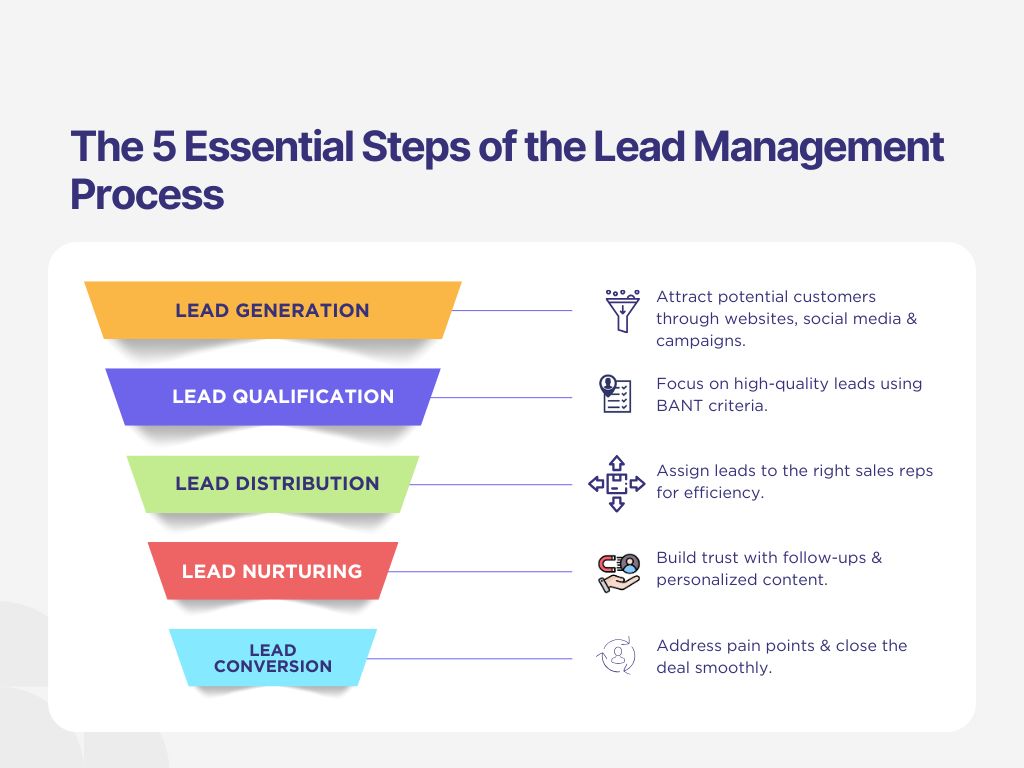Lead management is the backbone of any successful business’s sales and marketing strategy. It involves capturing, tracking, and nurturing potential customers, ensuring they move seamlessly through the sales funnel. This article dives into the lead management process, the challenges involved, the role of technology, and best practices to ensure your business maximizes its potential.
The Lead Management Process
Lead management is a multi-step approach that ensures potential customers are guided through their journey toward making a purchase. Here are the key steps:

- Lead Generation: The process begins with identifying and attracting potential customers through various channels, including websites, social media, email campaigns, and offline events. Effective marketing campaigns with lead capture forms or calls-to-action are essential for successful lead generation.
- Lead Qualification: Not all leads are created equal. Qualification ensures that sales teams focus on high-quality leads more likely to convert. Using frameworks like BANT (Budget, Authority, Need, and Timeline), businesses evaluate whether a lead is worth pursuing.
- Lead Distribution: Qualified leads are assigned to appropriate sales representatives or teams. Proper distribution prevents bottlenecks and ensures leads are handled efficiently.
- Lead Nurturing: Once distributed, leads often require nurturing. Personalized email campaigns, follow-ups, and targeted content help build trust and keep prospects engaged.
- Lead Conversion: The final step is converting leads into customers. This involves addressing their pain points, answering questions, and facilitating a smooth purchase process.
An effective lead management process creates a streamlined sales funnel that minimizes inefficiencies, reduces the risk of lost opportunities, and boosts conversion rates. By fostering collaboration between marketing and sales teams, this process ensures every lead is handled appropriately and at the right time.
Challenges in Lead Management
While lead management is essential for business success, it comes with its share of challenges. Here are the most common obstacles and how they can affect businesses:
- Lead Overload: Generating too many leads without an efficient system to handle them can overwhelm sales teams. This often results in neglected or delayed follow-ups, which can frustrate prospects.
- Poor Lead Qualification: Without a proper qualification process, teams may waste time pursuing leads unlikely to convert. This reduces efficiency and morale for sales teams.
- Data Silos: Inconsistent or inaccessible data is a significant challenge in lead management. When marketing and sales teams rely on different data sources, it creates gaps that hinder the nurturing process.
- Disjointed Communication: Misalignment between marketing and sales teams can lead to mixed messaging, confusing potential customers and damaging trust.
- Lack of Technology: Without appropriate tools like a CRM or marketing automation platform, tracking and managing leads becomes a manual and error-prone process.
- Inadequate Follow-Ups: Research shows that leads who aren’t followed up with promptly are less likely to convert. Many businesses lose opportunities due to delayed or inconsistent follow-ups.
To address these challenges, businesses must invest in robust tools, establish clear communication protocols, and develop a well-defined lead management strategy. Overcoming these obstacles will ensure a smoother lead conversion process, ultimately boosting business success.
The Role of Technology in Lead Management
Technology is the driving force behind modern lead management systems. Tools like CRM (Customer Relationship Management) platforms and marketing automation software have revolutionized how businesses capture, track, and nurture leads. Here’s how technology enhances the process:
- Centralized Data Management: CRMs store all lead data in one place, ensuring marketing and sales teams have a unified view. This eliminates data silos and improves collaboration.
- Lead Scoring: Automation tools evaluate and rank leads based on predefined criteria such as engagement levels, demographics, and behavior. This helps sales teams prioritize high-potential leads.
- Personalized Engagement: Marketing automation platforms enable businesses to send targeted emails, messages, or ads to leads based on their behavior and preferences. This personalization significantly improves conversion rates.
- Workflow Automation: Tasks like assigning leads, scheduling follow-ups, and sending reminders can be automated. This reduces manual effort and ensures no lead is left unattended.
- Analytics and Insights: Technology provides businesses with valuable data on lead sources, conversion rates, and campaign performance. These insights enable continuous optimization of the lead management process.
- Omnichannel Engagement: Tools enable businesses to interact with leads across multiple platforms, including social media, email, chatbots, and websites, ensuring consistent and cohesive communication.
Investing in the right tools can dramatically improve a business’s ability to manage leads effectively. By automating repetitive tasks, providing actionable insights, and enabling personalized communication, technology empowers businesses to scale their lead management processes while maintaining a high level of efficiency and accuracy.
Best Practices for Effective Lead Management
To succeed in lead management, businesses must adopt a strategic approach that focuses on both efficiency and personalization. Here are some proven best practices:
- Define Clear Lead Qualification Criteria: Establish frameworks like BANT or lead scoring models to determine which leads deserve attention. This ensures sales teams focus their efforts on high-potential opportunities.
- Align Marketing and Sales Teams: Collaboration between these teams is crucial. Regular meetings, shared goals, and unified tools like a CRM ensure everyone is on the same page regarding lead priorities.
- Use Technology Wisely: Automate routine tasks like follow-ups, email campaigns, and data entry while keeping human interaction for high-touch engagements. This balance improves efficiency without compromising personalization.
- Focus on Lead Nurturing: Leads rarely convert on the first interaction. Use personalized email sequences, targeted content, and timely follow-ups to keep prospects engaged and informed.
- Segment Your Leads: Divide leads into segments based on their behavior, demographics, or stage in the sales funnel. This enables targeted communication that resonates with their specific needs.
- Track and Measure Performance: Use analytics tools to monitor key metrics like conversion rates, lead sources, and nurturing effectiveness. Regularly review this data to optimize your lead management strategy.
- Continuously Train Your Teams: Sales and marketing teams should be trained on new tools, trends, and techniques in lead management. Regular workshops and updates keep teams effective and adaptable.
- Follow Up Quickly: Leads expect prompt responses. Establish SLAs (Service Level Agreements) to ensure follow-ups happen within a specific timeframe.
By following these practices, businesses can create a lead management system that is both scalable and effective, ultimately driving better results and long-term customer relationships.
Did you find this article helpful? Discover more engaging insights and solutions from Legitt AI, including advanced sales enablement tools, an AI-powered proposal generator, and cutting-edge AI sales chatbot software. Contact us today to elevate your business with Legitt AI CRM software. Empower your business with Legitt AI!
FAQs on Lead Management
What is lead management?
Lead management is the process of capturing, qualifying, nurturing, and converting potential customers into paying clients through a structured and systematic approach.
Why is lead management important for businesses?
It maximizes sales efficiency, improves ROI, enhances customer experiences, and ensures no opportunities are lost.
What are the key stages of the lead management process?
The process includes lead generation, qualification, distribution, nurturing, and conversion.
What tools are essential for lead management?
CRM platforms, marketing automation tools, and analytics software are crucial for tracking and managing leads effectively.
What is lead nurturing?
Lead nurturing involves building relationships with potential customers through personalized and targeted communication until they are ready to purchase.
How does technology improve lead management?
Technology automates tasks, centralizes data, scores leads, and enables personalized and omnichannel engagement.
What are common challenges in lead management?
Challenges include lead overload, poor qualification, data silos, disjointed communication, and inadequate follow-ups.
How can businesses improve their lead management process?
By adopting best practices like clear qualification criteria, aligning marketing and sales, and using technology effectively.
What is lead scoring?
Lead scoring is a system that ranks leads based on their likelihood to convert, using factors like engagement and demographics.
How does lead management impact sales performance?
Effective lead management boosts conversion rates, reduces acquisition costs, and ensures sales teams focus on high-priority opportunities.
